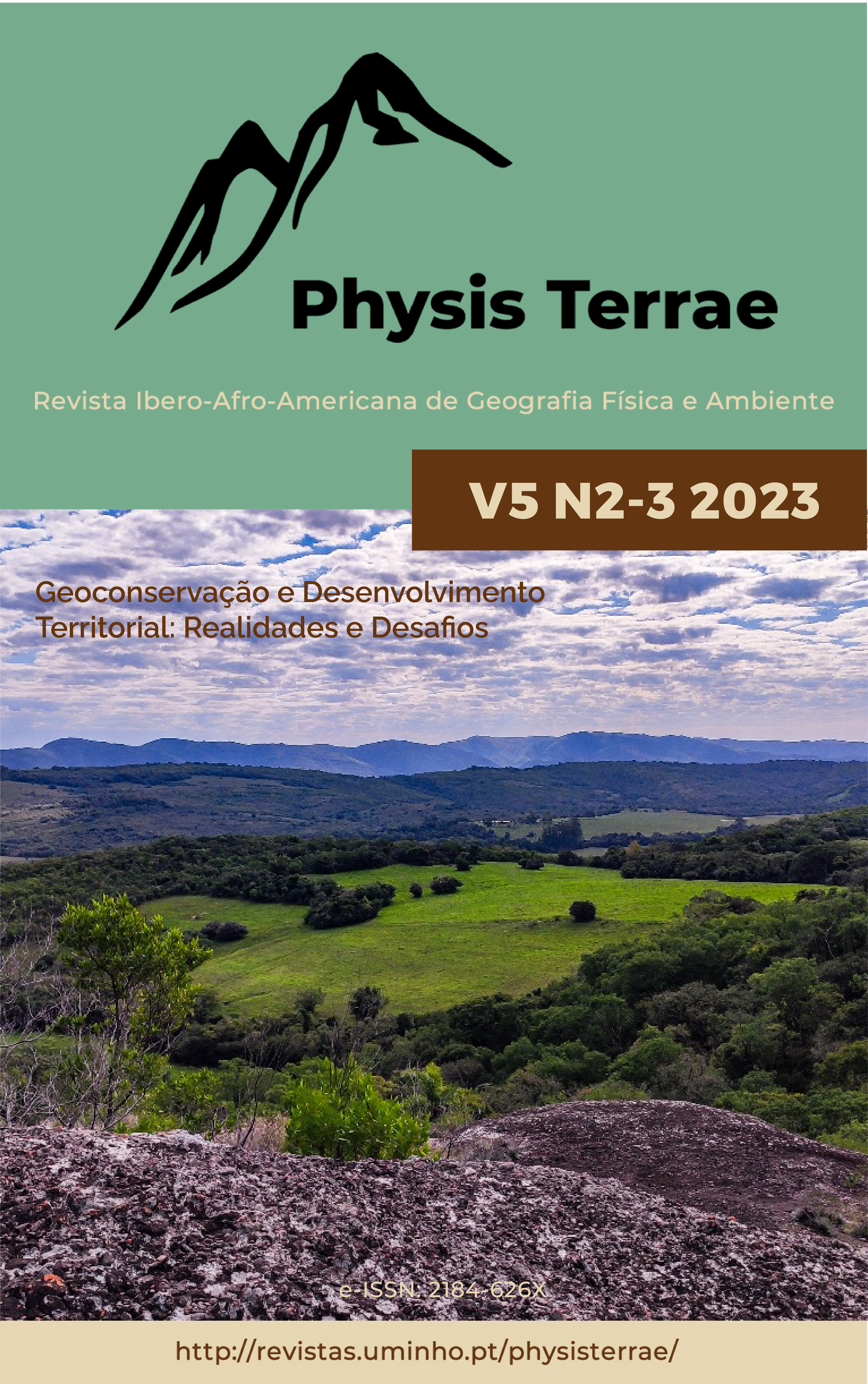Geodia as an of educational basis for the certification of the Caçapava UNESCO Global Geopark
DOI:
https://doi.org/10.21814/physisterrae.5558Keywords:
UNESCO Global Geopark, Geoeducation, Caçapava do Sul, GeoheritageAbstract
The UNESCO (UN organization for education, science and culture) certificates territories as Global Geoparks, through the work of the Global Geoparks Network (GGN). In this sense, Geoparks are territories which have unique geological, geomorphological and/or paleontological heritage aspects, and which apply development projects in the fields of geotourism, geoconservation, and geoeducation. The municipality of Caçapava do Sul, located in the central region of the Rio Grande do Sul State, Brazil, displays a great geodiversity, and it was certified in 2015 as the “State’s capital of geodiversity” (State law 14.708). The reasons for this recognition are the unique features of geodiversity and geoheritage. Among the strategies for the certification of a geopark, geoeducation initiatives are highlighted. In Caçapava do Sul, the Geodia (geo-day) occurs since 2015, and it seeks for popularization of geoheritage knowledge for children and teenagers, as well as for the community as a whole. Therefore, this communication seeks to address the importance of geoeducational projects of non-formal education for the certification of the Caçapava UNESCO Global Geopark, as well as to present the Geodia, which is of paramount importance for the dissemination of geodiversity concepts and to the understanding of the reasons that led to the certification of Caçapava as a UNESCO Global Geopark.
Downloads
References
Borba A.W., Souza L.F., Mizusaki A.M.P., Almeida D.P.M., & Stumpf P.P. (2013). Inventário e avaliação quantitativa de geossítios: exemplo de aplicação ao patrimônio geológico do município de Caçapava do Sul (RS, Brasil). Pesquisas em Geociências, 40(3), 275-294. https://doi.org/10.22456/1807-9806.77830
Borba, A. W. de, Teixeira, K. M., Ferreira, P. F., & Ferreira, P. F. (2015). Concepções dos professores de ciências naturais da rede pública de Caçapava do Sul (RS, Brasil) sobre a geologia local: subsídios à educação geopatrimonial. Terrae Didatica, 11(2), 117-124,. https://doi.org/10.20396/td.v11i2.8640730
Brilha, J. B. R. A importância dos geoparques no ensino e divulgação das Geociências. Geologia USP, Publicação Especial, 5, 27-33, 2009. https://doi.org/10.11606/issn.2316-9087.v5i0p27-33
Brilha, J. B. R. (2012). A Rede Global de Geoparques Nacionais: um instrumento para a promoção internacional da geoconservação. In Schobbenhaus, Carlos, Silva, Cássio Roberto (Orgs.) Geoparques do Brasil – Propostas, CPRM, p. 29-37,. Disponível em: http://dspace.cprm.gov.br/bitstream/doc/17162/1/GeoparquesDoBrasil_cap2.pdf. Acesso em 23 jun. 2023.
Corrêa, A. P. S., Borba, A. W., Guadagnin, F., Silva, E. L., & Souza, L. P. M. (2018). A Experiência do geo.dia como ferramenta de valorização e divulgação do conhecimento geológico no município de Caçapava do Sul (RS, Brasil). Terr@ Plural, 12(2), 254-269. Disponível em: https://revistas.uepg.br/index.php/tp/article/view/11789
Da Silva, J. V. M., & De Moura-Fé, M. M. (2020). A geodiversidade na Geografia Escolar: Reflexões teóricas e a importância da geoeducação. Revista GEOMAE, 11(1), 143-157. Disponível em: https://periodicos.unespar.edu.br/index.php/geomae/article/view/7695
Feitosa, G. T. (2014). Ocorrências de Eremotherium laurillardi (Xenarthra, Megatheriidae)e Stegomastodon waringi (Proboscidea, Gomphotheriidae) no Pleistoceno do estado de Goiás. Monografia (Curso de Ciências Biológicas). Universidade Estadual de Goiás, UEG. Anápolis, GO.
Gray, M. (2005). Geodiversity and geoconservation: what, why, and how?. The George Wright Forum, 22(3), 4-12. Disponível em: https://www.jstor.org/stable/43597951
Instituto Brasileiro de Geografia e Estatística (IBGE). Censo Brasileiro de 2022. Rio de Janeiro: IBGE, 2022. Disponível em 28/06/2023 em: https://censo2022.ibge.gov.br/panorama/
Moura-Fé, M. M., Pinheiro, M., Jacó, D., & Oliveira, B. (2016). Geoeducação: a educação ambiental aplicada na geoconservação. In Giovanni Seabra (Org.). Educação Ambiental & Biogeografia (pp. 829-842). Vol. 2. Ituiutaba: Barlavento.
Oliveira, E. V., Dutra, T. L., & Zeltzer, F. (2002). Megaterídeos (Mammalia, Xenarthra) do Quaternário de Caçapava do Sul, Rio Grande do Sul, com considerações sobre a flora associada. Geología Colombiana, 27, 77-86. Disponível em: https://revistas.unal.edu.co/index.php/geocol/article/view/31588
Vieira, E. F. (1984). Rio Grande do Sul: geografia física e vegetação. Porto Alegre: Sagra.
Downloads
Published
How to Cite
Issue
Section
License
Copyright (c) 2023 Eduarda Caroline Brum, André Weissheimer de Borba, Josiane Oliveira de Campos

This work is licensed under a Creative Commons Attribution 4.0 International License.


